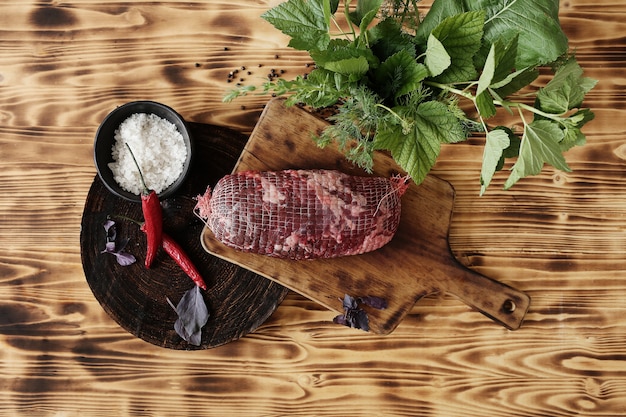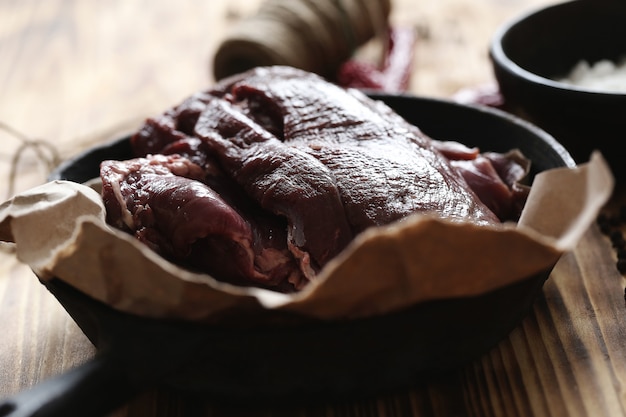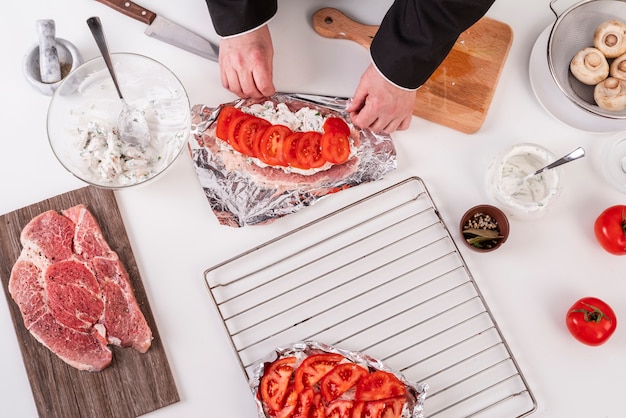Let's be honest, there's something truly satisfying about a beautifully cooked rib of beef. The rich, deep flavour, the melt-in-your-mouth tenderness, and that gloriously crispy crust – it's a culinary masterpiece waiting to happen. But let's face it, achieving that perfect roast isn't always a walk in the park.
Over the years, I've had my fair share of triumphs and, well, let's just say, "learning experiences" in the kitchen. But after countless experiments and a few burnt offerings, I've finally cracked the code to consistently deliver a rib of beef that's worthy of a standing ovation. So, grab a comfy seat, pour yourself a glass of something delicious, and let's embark on this culinary adventure together.
(Part 1) Choosing Your Rib of Beef: The Foundation of Flavor

The journey begins with the star of the show: your rib of beef. choosing the right cut is essential – it's like selecting the perfect canvas for your culinary masterpiece.
What to Look For: A Guide to the Perfect Rib
Don't be intimidated by all the different cuts at the butcher's. You're looking for a few key features:
Marbling, Marbling, Marbling: This is the key to juicy, flavourful beef. Imagine it as tiny veins of fat running through the meat, like a delicious network. Look for a good, even distribution of marbling – it's like a secret ingredient that adds richness and tenderness.
Colour Matters: A vibrant, deep red colour signals fresh, high-quality beef. Avoid anything that looks grey or brown – it's a telltale sign that the meat hasn't been stored properly.
The Bone: A Flavor Amplifier: I'm a firm believer in bone-in rib of beef. The bone acts like a little heat conductor, keeping the meat moist and flavourful as it cooks. Plus, it adds that extra layer of flavour we all crave.
Finding Your Beef Haven: Where to Buy
Now, where do you find this treasure? While you can find decent quality cuts at most supermarkets, I'm a big advocate for seeking out your local butcher. These are the meat whisperers, passionate about their craft and eager to help you choose the perfect cut for your needs. They're also a wealth of knowledge, so don't be afraid to ask questions. They'll guide you through the different cuts, explain the marbling, and even offer tips on how to cook it to perfection.
Sizing Up Your Feast: How Much Beef is Enough?
The size of your rib of beef depends on the number of hungry mouths you need to feed. For a family meal, I usually go for a 2-3kg (4.5-6.5lb) rib of beef. This provides generous servings without being overwhelming. But for a larger gathering, you might need to scale up your purchase.
(Part 2) Seasoning and Prepping: Enhancing the Natural Flavors

Okay, your stunning rib of beef is ready to be transformed into a culinary masterpiece. But first, a little magic touch: seasoning.
Seasoning Secrets: A simple recipe for Success
I keep my seasoning simple, focusing on enhancing the natural flavours of the beef:
Salt: The Flavor Booster: Good quality sea salt is your best friend here. Don't be shy – salt liberally! It helps to draw out the natural moisture and flavour from the beef.
Black Pepper: A Touch of Spice: Freshly ground black pepper is a must-have. It adds a delightful kick and complexity to the flavour profile.
Herbal Delights: Optional Flavor Twists: For an extra flavour boost, I love adding fresh herbs like rosemary, thyme, or garlic. Just gently rub them into the surface of the beef – it's a simple touch that makes a world of difference.
Preparing Your Beef for its Culinary Transformation
Before you hit the oven or fire up the BBQ, there are a few important steps to ensure a perfect roast:
Pat it Dry: Pat the beef dry with kitchen paper. This removes any excess moisture, which helps to create a crisp, flavorful crust.
Herbal Embrace (Optional): If you're using herbs, rub them thoroughly into the surface of the beef. This allows the flavours to penetrate deep into the meat while it cooks.
(Part 3) The Cooking Methods: Oven vs. BBQ - Which is Right for You?

Now comes the fun part – the actual cooking! You have two main contenders: the trusty oven or the sizzling BBQ.
The Oven: A Tried and True Classic
This is my go-to method for a rib of beef. It's straightforward, reliable, and always delivers delicious results. Here's the breakdown:
1. Preheat your Oven to Searing Temperatures: Set your oven to 220°C/425°F. This high temperature helps to create a crispy, beautifully browned crust on the beef.
2. Roast to Perfection: Place the seasoned rib of beef in a roasting tin, fat side up. This allows the fat to render as it cooks, adding flavor and keeping the meat moist. You can also add some vegetables like onions, carrots, and potatoes for a delicious side dish.
3. High Heat for Initial Browning: Roast the beef for 30 minutes at the high temperature. This gives it a head start on that glorious crust.
4. Lower the Heat for Tenderness: After 30 minutes, reduce the oven temperature to 160°C/325°F. This allows the beef to cook through more gently, ensuring tenderness.
5. Cook Time Varies: The cooking time depends on the size of your rib of beef and your desired level of doneness. For a medium-rare roast, cook for 20-25 minutes per pound. For a medium roast, aim for around 25-30 minutes per pound.
6. Rest is Key: Once the beef is cooked, remove it from the oven and let it rest for 15-20 minutes before carving. This allows the juices to redistribute throughout the meat, making it incredibly tender and juicy.
The BBQ: Adding Smoke and Flavor to Your Feast
If you're looking for that smoky, adventurous flavor, the BBQ is your perfect companion. Here's how to conquer this method:
1. BBQ Prep: Preheat your BBQ to medium-high heat.
2. Sizzling Start: Place the seasoned rib of beef on the BBQ and cook for 5-7 minutes per side, until you achieve a beautiful, crispy brown crust.
3. Moving to Indirect Heat: Once the beef is nicely browned, move it to the indirect heat zone of your BBQ. This prevents it from burning while it cooks through.
4. Cook Until Done: Continue to cook for 20-25 minutes per pound, until the beef reaches your desired level of doneness.
5. Rest Time is Crucial: Remove the beef from the BBQ and let it rest for 15-20 minutes before carving. This allows the juices to redistribute, resulting in a tender and succulent feast.
(Part 4) Checking the Doneness: No More Guesswork!
The moment of truth is approaching – checking the doneness of your rib of beef. No one wants a dry, overcooked disaster.
The Finger Test: A Reliable Guide (for those who dare)
This is my go-to method – it's simple, accurate, and a great way to become more familiar with the feel of different levels of doneness:
1. Gentle Touch: Press the thickest part of the beef with your finger. The feel will tell you all you need to know.
2. Rare: If the beef feels very soft and squishy, it's rare.
3. Medium-rare: A slightly firmer feel indicates medium-rare.
4. Medium: If the beef feels firmer, it's medium.
5. Well-done: A very firm, almost hard feel means it's well-done.
meat thermometer: Your Precise Partner
If you prefer a more scientific approach, a meat thermometer is your best friend. It takes the guesswork out of the equation:
| Doneness | internal temperature (°C) | Internal Temperature (°F) |
|---|---|---|
| Rare | 47-49 | 115-120 |
| Medium-rare | 52-54 | 125-130 |
| Medium | 57-60 | 135-140 |
| Well-done | 63-65 | 145-150 |
(Part 5) The Art of Resting: A Crucial Step for Juicy Results
Resting the beef after cooking is a crucial step. It's like giving the meat a chance to relax and redistribute those precious juices, ensuring a tender, juicy result.
Why Resting is So Important: A Tale of Juices
Imagine the juices in the meat like tiny little prisoners trapped in a cage. When the meat is hot, those prisoners are restless, eager to escape. Resting allows the juices to settle back down and redistribute throughout the meat, making it incredibly tender and juicy.
Resting Time: The Longer the Better
Rest your beef for at least 15-20 minutes before carving. The longer you can rest it, the better. I usually let my rib of beef rest for about 30 minutes.
Resting Techniques: Keeping It Warm and Cozy
You can rest the beef directly on a chopping board, but I prefer to use a roasting tin or a large plate covered with foil. This helps to keep the beef warm while it's resting.
(Part 6) Carving Your Rib of Beef: A Masterclass in Presentation
Now it's time to unleash the masterpiece – carving your rib of beef. This is where the showmanship comes in, but don't worry, it's easier than you think.
Carving Tips: Achieving Clean, Even Slices
I've learned a few tricks over the years to make carving easier and more elegant. Here's my playbook:
Sharp Knife is King: A sharp knife is essential for clean, even slices. Don't be tempted to use a dull knife – it will make your life much harder.
Starting at the Bone: If you have a bone-in rib of beef, start carving by slicing along the bone. This helps to keep the slices neat and consistent.
Across the Grain: For tender slices, cut across the grain of the meat. This helps to break down the muscle fibers, making the meat easier to chew.
Patience is Key: Don't try to carve the entire roast at once. Carve it in smaller portions to keep it warm and prevent it from drying out.
(Part 7) Delicious Gravy and Yorkshire Pudding: The Perfect Accompaniments
No rib of beef roast is complete without its glorious entourage: gravy and Yorkshire pudding.
The Gravy: A Rich, Flavorful Sauce
Gravy adds a touch of magic to your roast – it's the finishing touch that elevates the entire meal. Here's my foolproof recipe:
1. Juice Collection: Once you've removed the beef, pour the juices from the roasting tin into a saucepan. This liquid gold is the foundation of your gravy.
2. Flour Magic: Whisk in a tablespoon or two of flour and cook over a low heat, stirring constantly, until it's smooth. This forms the base of your sauce.
3. Stock Infusion: Gradually add hot stock or water, stirring constantly, until the gravy reaches your desired consistency. You can use beef stock for a richer flavor or chicken or vegetable stock for a lighter touch.
4. Season to Perfection: Season the gravy with salt, pepper, and any other desired herbs or spices. I love adding a pinch of freshly chopped parsley for a pop of color and flavor.
The Yorkshire Pudding: A Light and Fluffy Companion
Yorkshire pudding is a quintessential accompaniment to roast beef. It's light, fluffy, and wonderfully absorbent, soaking up all the delicious juices from your gravy.
1. Oven Prep: Preheat your oven to 220°C/425°F.
2. Batter Bliss: Whisk together 1 cup of plain flour, 1 teaspoon of salt, and 2 large eggs. Gradually add 1 cup of milk, whisking constantly until you have a smooth batter.
3. Hot Fat is Key: Heat a tablespoon or two of beef dripping or vegetable oil in a baking tin or a muffin tray. The fat should be very hot and sizzling.
4. Baking Time: Pour the batter into the hot fat and bake for 20-25 minutes, until golden brown and risen.
5. Serve Immediately: Serve the yorkshire puddings immediately with the roast beef and gravy. They're best enjoyed fresh from the oven.
(Part 8) Serving Suggestions: Completing Your Culinary Masterpiece
Now that your rib of beef is ready to shine, it's time to think about the perfect sides to complement its deliciousness.
roast vegetables: A Classic Side Dish
Roast vegetables are a classic accompaniment to rib of beef. I love the earthy sweetness of carrots, the creamy texture of potatoes, the tang of onions, and the subtle sweetness of parsnips.
1. Preparing Your Vegetables: Toss the vegetables with olive oil, salt, pepper, and herbs. I often use a mix of rosemary, thyme, and garlic for a flavourful touch.
2. Roast Alongside the Beef: Place the vegetables in a roasting tin with the beef. This allows them to roast alongside the beef, absorbing its delicious juices.
Green Salad: A Refreshing Contrast
A simple green salad is a refreshing contrast to the richness of the roast beef. It adds a burst of color and a touch of lightness to your meal.
1. Choose Your Greens: I usually opt for a mix of leafy greens, such as romaine lettuce, spinach, or arugula.
2. Add Some Crunch: Toss in some cherry tomatoes, cucumber, and red onion for added texture and flavour.
3. Light Dressing: A light vinaigrette dressing is perfect for complementing the flavours of the roast beef and vegetables.
Other Sides: Exploring flavor combinations
If you're feeling adventurous, there are plenty of other delicious sides you can explore:
mashed potatoes: creamy mashed potatoes are a classic comfort food that pairs beautifully with roast beef.
Dauphinoise Potatoes: These thinly sliced potatoes layered with cream and cheese offer a rich and creamy alternative to mashed potatoes.
Roasted Garlic: Roasting garlic in the oven until soft and caramelized adds a sweet and savory flavor to your meal.
(Part 9) FAQs: Your Rib of Beef Questions Answered
You've got questions, I've got answers. Here's a compilation of frequently asked questions about rib of beef, all answered for your culinary convenience:
What is the best way to store leftover rib of beef?
Leftover rib of beef can be stored in the refrigerator for up to 3 days. Wrap it tightly in plastic wrap or aluminum foil to prevent drying.
Can I freeze rib of beef?
Yes, you can freeze rib of beef for up to 3 months. Wrap it tightly in plastic wrap or aluminum foil and place it in a freezer-safe bag. Thaw it in the refrigerator overnight before cooking.
What can I do with leftover gravy?
Leftover gravy can be stored in the refrigerator for up to 3 days. You can use it to make shepherd's pie, or you can reheat it and serve it with leftover roast beef.
Is there a difference between a rib roast and a prime rib roast?
A rib roast and a prime rib roast are essentially the same thing. The term "prime rib" is more common in the United States, while "rib roast" is more common in the UK and other parts of the world.
What is the best way to cook a rib of beef for a large crowd?
If you're cooking a rib of beef for a large crowd, you can cook it in a slow cooker. This method is perfect for cooking a large piece of meat over low heat for a long period of time. Just place the seasoned rib of beef in the slow cooker and cook on low heat for 6-8 hours. You can also use a dutch oven or a roasting tin in the oven, just make sure it's a large enough container for the meat.
There you have it, my friends, the ultimate guide to cooking rib of beef perfectly. Now go forth and conquer those kitchens!
Everyone is watching

Perfect Rice Every Time: The Ultimate Guide to Cooking Rice
Cooking TipsAs a self-proclaimed foodie, I've always been a bit obsessed with rice. It's the foundation of countless cuisi...

Prime Rib Roast Cooking Time Chart: Per Pound Guide
Cooking TipsPrime rib roast. Just the name conjures images of lavish dinners, crackling fires, and hearty laughter. It’s ...

The Ultimate Guide to Cooking Asparagus: Tips, Techniques, and Recipes
Cooking TipsAsparagus. The mere mention of this spring delicacy conjures up images of vibrant green spears, crisp and burs...

Ultimate Guide to Cooking the Perfect Thanksgiving Turkey
Cooking TipsThanksgiving. Just the word conjures up images of overflowing tables laden with delicious food, the scent of r...

How Long to Bake Potatoes in the Oven (Perfect Every Time)
Cooking TipsBaked potatoes are a staple in my kitchen. They're incredibly versatile, delicious, and surprisingly easy to m...
